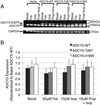Gain-of-function ADCY5 mutations in familial dyskinesia with facial myokymia
- PMID: 24700542
- PMCID: PMC4457323
- DOI: 10.1002/ana.24119
Gain-of-function ADCY5 mutations in familial dyskinesia with facial myokymia
Abstract
Objective: To identify the cause of childhood onset involuntary paroxysmal choreiform and dystonic movements in 2 unrelated sporadic cases and to investigate the functional effect of missense mutations in adenylyl cyclase 5 (ADCY5) in sporadic and inherited cases of autosomal dominant familial dyskinesia with facial myokymia (FDFM).
Methods: Whole exome sequencing was performed on 2 parent-child trios. The effect of mutations in ADCY5 was studied by measurement of cyclic adenosine monophosphate (cAMP) accumulation under stimulatory and inhibitory conditions.
Results: The same de novo mutation (c.1252C>T, p.R418W) in ADCY5 was found in both studied cases. An inherited missense mutation (c.2176G>A, p.A726T) in ADCY5 was previously reported in a family with FDFM. The significant phenotypic overlap with FDFM was recognized in both cases only after discovery of the molecular link. The inherited mutation in the FDFM family and the recurrent de novo mutation affect residues in different protein domains, the first cytoplasmic domain and the first membrane-spanning domain, respectively. Functional studies revealed a statistically significant increase in β-receptor agonist-stimulated intracellular cAMP consistent with an increase in adenylyl cyclase activity for both mutants relative to wild-type protein, indicative of a gain-of-function effect.
Interpretation: FDFM is likely caused by gain-of-function mutations in different domains of ADCY5-the first definitive link between adenylyl cyclase mutation and human disease. We have illustrated the power of hypothesis-free exome sequencing in establishing diagnoses in rare disorders with complex and variable phenotype. Mutations in ADCY5 should be considered in patients with undiagnosed complex movement disorders even in the absence of a family history.
© 2014 American Neurological Association.
Conflict of interest statement
J.R.F.: husband is biotech investor with investments in the sequence analysis and therapeutics space. P.H.P.: employment, stock, Cypher Genomics. A.A.S.-V.Z.: cofounder, employee, stock, Cypher Genomics. E.J.T.: cofounder, stock, Cypher Genomics; advisor, Illumina. T.D.B.: patent licensing royalties from Athena Diagnostics. N.J.S.: cofounder, consultant, patent, stock, Cypher Genomics. A.T.: cofounder, consultant, patent, stock, Cypher Genomics.
Figures



References
-
- Matsuoka I, Suzuki Y, Defer N, et al. Differential expression of type I, II, and V adenylyl cyclase gene in the postnatal developing rat brain. J Neurochem. 1997;68:498–506. - PubMed
-
- Iwamoto T, Okumura S, Iwatsubo K, et al. Motor dysfunction in type 5 adenylyl cyclase-null mice. J Biol Chem. 2003;278:16936–16940. - PubMed
Publication types
MeSH terms
Substances
Grants and funding
LinkOut - more resources
Full Text Sources
Other Literature Sources
Medical
Molecular Biology Databases

